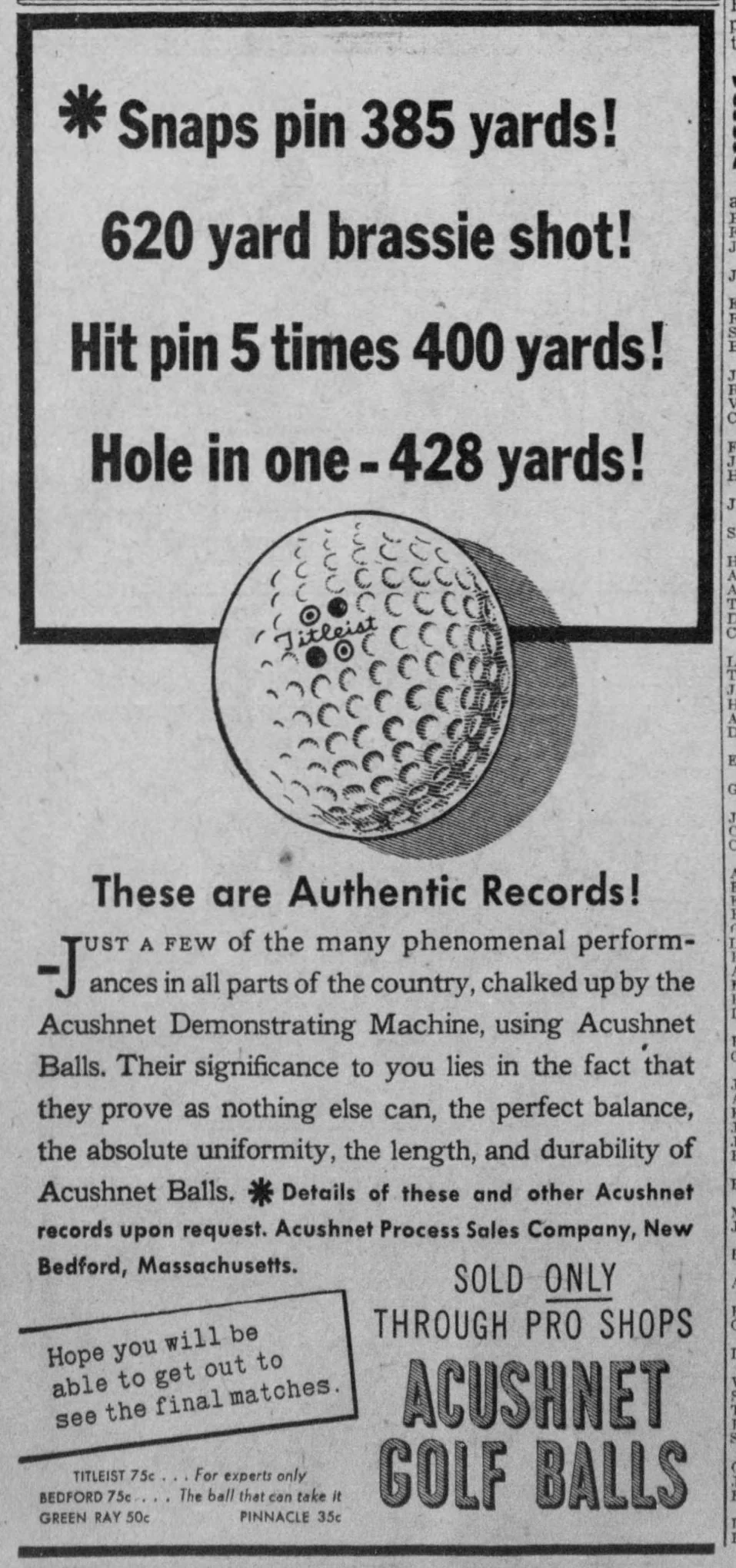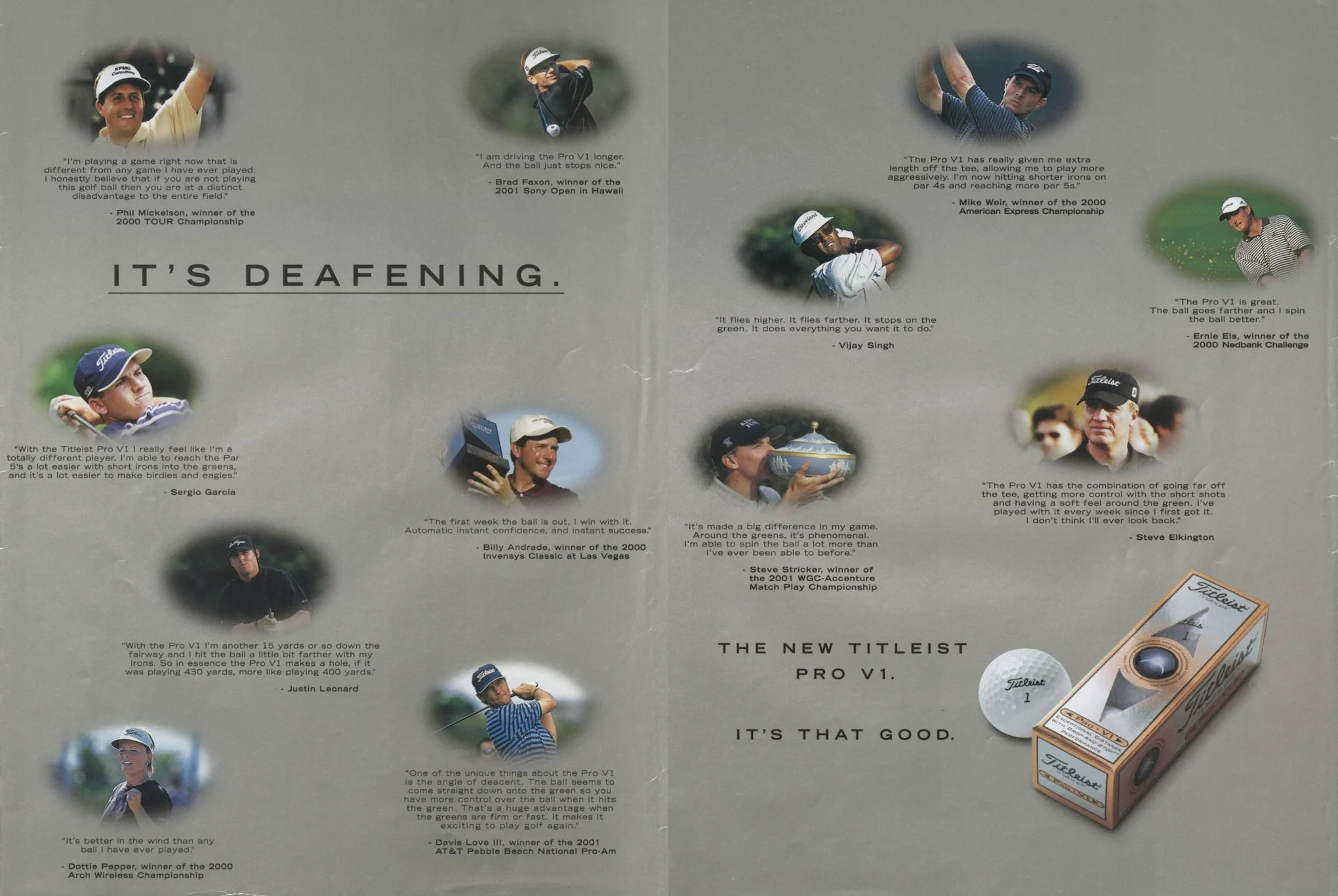For over nine decades, Titleist has established itself as the leading name in golf equipment, particularly renowned for its high-quality golf balls. The company’s marketing campaigns have been instrumental in shaping its reputation and influencing golf enthusiasts worldwide. Titleist’s print advertising has evolved alongside the sport, showcasing not only the brand’s commitment to technological innovation but also its deep understanding of the cultural and emotional elements that resonate with players.

Image: Titleist.com
From the early days of black-and-white ads to the more modern, sophisticated campaigns of the 21st century, Titleist’s print ads have reflected the changing trends in golf and advertising. These campaigns have consistently emphasized the precision, consistency, and performance of Titleist golf balls, while also associating the brand with top athletes and moments in golf history. By examining the evolution of Titleist's advertising over the years, one can gain insight into both the history of the company and the broader narrative of golf as a sport.
To get the word out about their breakthrough golf balls, the company built the “Acushnet Field Demonstrator” and went on a national barnstorming tour. The machine cranked 400 yard drives in 1936, and 1939 ads boasted about 600 yard bombs and 400 yard hole-in-ones.
The Acushnet brand was highly prominent in these early ads, but would gradually fade into the background over the next five decades. In addition to Titleist, Acushnet manufactured three other ball brands back then: Bedford, Green Ray, and Pinnacle. Pinnacle is still owned by Acushnet to this day.
Additionally, Titleist's strategy during this period highlighted that the company didn’t pay tour pros to use its balls, a point made clear in ads with phrases like “No one is paid to play Titleist.” This claim was a staple in Titleist advertisements until the early 1970s.
In 1968, Titleist got a little playful by branding its golf balls as Bandits, a nod to their ability to capture winnings at golf tournaments. This creative approach lasted for two years.
In contrast, Titleist offered the Titleist DT ball, designed with a DuPont Surlyn cover and a wound interior for enhanced durability. This ball lasted significantly longer than the more expensive balata golf balls. The 1970s marked the end of Titleist's black-and-white ads.
While the Acushnet brand became much less prominent, it still maintained a diminished presence in golf ball ads.
In a notable departure from tradition, a 1998 Titleist ad in Sports Illustrated showcased its roster of sponsored tour players for the first time, featuring notable pros (from left to right) Tom Lehman, Davis Love III, Ernie Els, Colin Montgomerie, Karie Webb, David Duval, Phil Mickelson, Justin Leonard, and Tiger Woods, who had won his first Masters the previous year. This marked a significant change from the company's decades earlier stance that “no one is paid to play Titleist.”
In the mid-2000s, Titleist expanded its lineup with the NXT series, accompanied by playful print and TV advertisements featuring comedic actor John Cleese. This marked a return to the brand's cheeky advertising style reminiscent of the late 1960s.
In the present era, print publications are grappling with challenges and diminishing appeal, leading to a reduction in available ad space. Consequently, print ads have lost much of their former impact. Titleist's contemporary marketing strategy heavily leans towards television and digital platforms due to these shifts. Nonetheless, delving into the history of their golf ball advertisements offers a deeper understanding of how the sport of golf has evolved and perceived itself over the span of nine decades.

From the early days of black-and-white ads to the more modern, sophisticated campaigns of the 21st century, Titleist’s print ads have reflected the changing trends in golf and advertising. These campaigns have consistently emphasized the precision, consistency, and performance of Titleist golf balls, while also associating the brand with top athletes and moments in golf history. By examining the evolution of Titleist's advertising over the years, one can gain insight into both the history of the company and the broader narrative of golf as a sport.
1930s - The origin story
The Titleist brand began in 1932 when Phil Young, an amateur golfer and owner of the Acushnet rubber company, discovered that an off-center core caused a missed putt during a match. Young collaborated with Fred Bommer, a rubber specialist, to develop a golf ball with uniform and consistent quality. After three years of effort, the first Titleist ball was released in 1935 and introduced as the best ball ever made, with every ball x-rayed to ensure quality control.To get the word out about their breakthrough golf balls, the company built the “Acushnet Field Demonstrator” and went on a national barnstorming tour. The machine cranked 400 yard drives in 1936, and 1939 ads boasted about 600 yard bombs and 400 yard hole-in-ones.
The Acushnet brand was highly prominent in these early ads, but would gradually fade into the background over the next five decades. In addition to Titleist, Acushnet manufactured three other ball brands back then: Bedford, Green Ray, and Pinnacle. Pinnacle is still owned by Acushnet to this day.
1940s - A unique sales approach
In those days, most golf equipment was sold through department stores, but Titleist chose a different approach by exclusively selling its golf balls through golf course pro shops. This strategy allowed golf professionals to highlight the quality and value of Titleist balls more effectively than department store clerks could. Titleist's marketing consistently emphasized this distinction. Later, in the 1960’s, the specific phrase "Sold thru golf pro shops only” was used everywhere, which remained a part of its advertising until 1980.1950s - Now the #1 ball on tour
In 1949, Titleist achieved a major milestone when its golf balls were the most played at the US Open at Medinah, marking the first time the company reached this distinction at a major tournament. This accomplishment paved the way for Titleist's advertising to emphasize its popularity among top golfers. As all golfers know, it’s remained a central message in their marketing efforts -- since the 1950s. From 1978 onward, the phrase “#1 ball in golf” was incorporated into the Titleist logo.Additionally, Titleist's strategy during this period highlighted that the company didn’t pay tour pros to use its balls, a point made clear in ads with phrases like “No one is paid to play Titleist.” This claim was a staple in Titleist advertisements until the early 1970s.
1960s
The 1960s brought radical change, and Titleist's marketing adapted... slightly. The brand introduced more vibrant ads and highlighted themes such as superior ball feel (attributed to Acushnet’s “true liquid center”) and lasting gloss (due to scuff-resistant paint). These ads continued to emphasize Titleist as the preferred choice of professional golfers.In 1968, Titleist got a little playful by branding its golf balls as Bandits, a nod to their ability to capture winnings at golf tournaments. This creative approach lasted for two years.
1970s
The brief experiment with the Bandit’s creative branding was short-lived, and Titleist soon returned to its core focus on being the #1 ball in golf and emphasizing its key features. In the 1970s, Balata golf balls gained popularity due to their thin cover that provided high spin and feel, although they were more prone to scuffing and cutting compared to other balls. This seemed at odds with Titleist's reputation for producing durable, high-quality golf balls, so the company created ads to highlight the benefits of balata balls while also explaining their quicker degradation.In contrast, Titleist offered the Titleist DT ball, designed with a DuPont Surlyn cover and a wound interior for enhanced durability. This ball lasted significantly longer than the more expensive balata golf balls. The 1970s marked the end of Titleist's black-and-white ads.
While the Acushnet brand became much less prominent, it still maintained a diminished presence in golf ball ads.
1980s
The Acushnet brand faded from view, now only visible in the copyright text at the bottom of Titleist's ads. Despite this shift, Titleist's marketing remained consistent, emphasizing its reputation for durability and its status as the #1 ball in golf. The company took pride in its 384 dimple design, a point often touted by ball manufacturers as an advancement in performance. However, did dimple patterns ever generate enthusiasm in golfers? Personally, I say no.1990s
In the early 1990s, Titleist launched the two-piece Titleist HVC ball and emphasized the technical specs in its marketing campaigns. The company touted the ball as the longest and most durable two-piece option available, with a “cuboctahedron” dimple pattern that promoted optimal ball flight. This ball was later succeeded by the HP2 Tour and Distance balls, further focusing on the benefits of two-piece construction.In a notable departure from tradition, a 1998 Titleist ad in Sports Illustrated showcased its roster of sponsored tour players for the first time, featuring notable pros (from left to right) Tom Lehman, Davis Love III, Ernie Els, Colin Montgomerie, Karie Webb, David Duval, Phil Mickelson, Justin Leonard, and Tiger Woods, who had won his first Masters the previous year. This marked a significant change from the company's decades earlier stance that “no one is paid to play Titleist.”
2000s
The introduction of the Pro V1 golf ball in October 2000 during the Invensys Classic of Las Vegas marked a seismic shift in the golf industry. The Pro V1 quickly became the preferred choice among tour professionals, and its limited release to stores in 2001 sparked incredibly high demand among golfers. Titleist amplified the buzz with a four-page spread in the April 2001 Golf Digest, highlighting the ball's exceptional distance and Drop-and-Stop performance, accompanied by endorsements from numerous tour pros. This launch set a new standard in the industry. The Pro V1 stands not only as the most successful golf ball ever created, but also as the most successful piece of golf equipment overall. Titleist continues to offer updated versions of the Pro V1, maintaining its dominant position on tour and in the market.In the mid-2000s, Titleist expanded its lineup with the NXT series, accompanied by playful print and TV advertisements featuring comedic actor John Cleese. This marked a return to the brand's cheeky advertising style reminiscent of the late 1960s.
In the present era, print publications are grappling with challenges and diminishing appeal, leading to a reduction in available ad space. Consequently, print ads have lost much of their former impact. Titleist's contemporary marketing strategy heavily leans towards television and digital platforms due to these shifts. Nonetheless, delving into the history of their golf ball advertisements offers a deeper understanding of how the sport of golf has evolved and perceived itself over the span of nine decades.


























